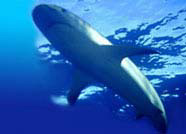


Swimming

 |
 |
 |
|||
| Home | Evolution
| Classification
| Glossary | Biology
| Behavior | Shark
Repellent | Shark
Conservation | Do's &
Don'ts | Did You Know?
Swimming |
 |
||||
|
Sharks swim by passing a series of waves down the body.
First the head oscillates from side to side, and then the amplitude of
the movement becomes progressively greater towards the tail. This pushes
a series of inclined surfaces outwards and backwards against the water
which, when pushed aside, causes the shark to move forwards. The tail
shape varies with lifestyle. Fast-swimming sharks, such as the makos and
the great white, have tail fins with an almost equal upper and lower lobe,
a feature they share with other fast swimmers, such as swordfish and sailfish.
Others, such as the tiger shark, have a tail with a long upper lobe, its
function a subject of debate amongst shark scientists. Some think that
it creates a thrust that is directed ventrally through the shark's center
of gravity, its body rather than its side fins providing lift. Others
believe that it produces a downward thrust that is countered by the shark's
pectoral fins.

The shape of a shark's tail is related to its function. High-speed sprinters have equal upper and lower lobes whilst open ocean hunters have tails with slightly larger upper lobes for cruising and slow-swimming bottom dwellers have large flat tails or tails with very large upper lobes. The extraordinarily long upper lobe of a thresher shark's tail may be an adaptation for stunning prey. The pectoral fins are like an aircraft's wings, and together with the slightly flattened underside of the body, they help provide the upward force of lift when the shark moves forward. In cross-section, they have the leading edge slightly thicker than the trailing edge, and as the water passes above and below the fin it moves more quickly over the top than the bottom surface. A partial vacuum forms on the upper side and a slight pressure pushes up on the underside that is sufficient to pull the fin (and the shark attached to it) upwards. The pectoral fin is also used for steering. The shark also remains buoyant thanks to an oil-filled liver. Some bottom-dwelling sharks, such as dogfish sharks, have livers that are 90 per cent oil. The oil is less dense than water (indeed, it floats at its surface) so the unusually large liver in most sharks helps keep them afloat. The basking shark, which can grow to over 9 m (30 ft) long, has a gigantic twin-lobed liver that is a quarter of its body weight and runs the entire length of its abdominal cavity. |
|
|||||||||||
| Sitemap | Reach To Us | Jimtrade - Business Directory of India | ||||||||||||